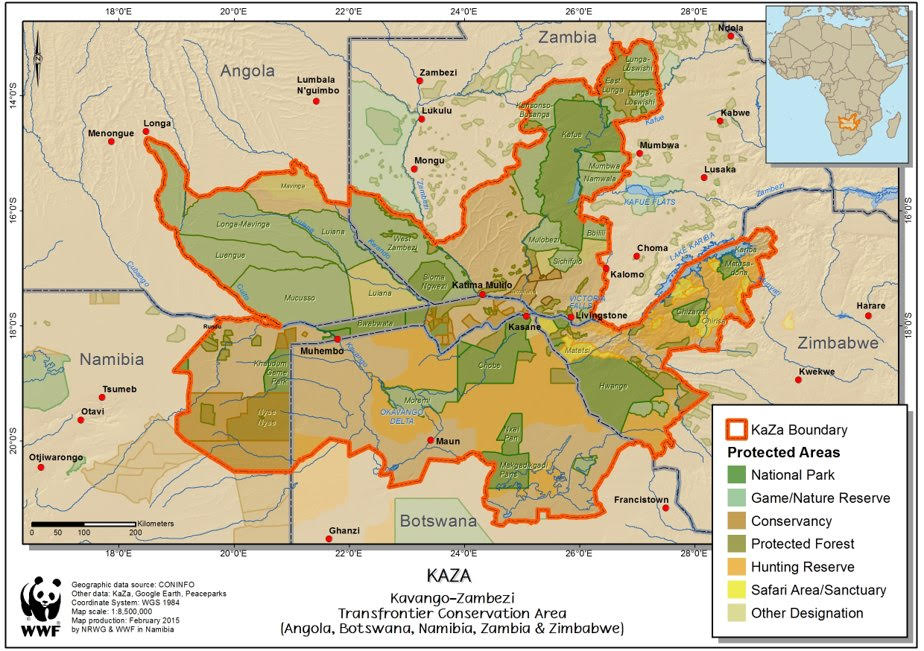The WWF is run at a local level by the following offices...
- WWF Global
- Adria
- Argentina
- Armenia
- AsiaPacific
- Australia
- Austria
- Azerbaijan
- Belgium
- Bhutan
- Bolivia
- Borneo
- Brazil
- Bulgaria
- Cambodia
- Cameroon
- Canada
- Caucasus
- Central African Republic
- Central America
- Central Asia
- Chile
- China
- Colombia
- Croatia
- Democratic Republic of the Congo
- Denmark
- Ecuador
- European Policy Office
- Finland
Over two decades, WWF has collaborated with governments, local communities, and environmental organizations across 5 Southern African nations to help establish and advance a large-scale, land-based conservation project: the Kavango- Zambezi Transfrontier Conservation Area (KAZA TFCA, or KAZA for short).
The landscape currently included under the KAZA Treaty covers contiguous parts of Angola, Botswana, Namibia, Zambia, and Zimbabwe. KAZA is the world’s largest TFCA, roughly the size of France or the size of Zimbabwe and Malawi combined. Vibrant, diverse communities of around 2.7 million people reside within its boundaries, mostly concentrated along the Okavango and Zambezi Rivers.
KAZA’s biodiversity and freshwater supply live in delicate balance. Maintaining this balance is critical for transboundary ecological connectivity, the flow of benefits to communities, and the protection of viable wildlife populations, including:
- 225,000 elephants - the largest elephant population in the world and around half of Africa's total
- 15% of the world's wild cheetahs
- 15% of Africa's lions
- 25% of Africa's wild dogs
conservancies, 11 sanctuaries, 103 wildlife management areas, and 11 game management areas. It is also home to 3 World Heritage Sites - Victoria Falls, Okavango Delta and Tsodilo Hills.

WWF’s KAZA Strategy provides a guideline for our part in building a connected, climate resilient, and economically viable conservation landscape for people and nature.
Wildlife in the KAZA region face threats from the intertwined issues of increasing poaching, habitat loss, fragmentation and degradation, human-wildlife conflict, insufficient incentives for communities to protect wildlife, increasing impacts of climate change, increasing human congregation in areas of high conservation value, and human infrastructure development along rivers and corridors. Poaching of elephants, pangolins, and rhinos, deforestation and illegal logging, and poisoning of wildlife endangers numerous species. Climate assessments anticipates significant contraction in the suitable range of carnivores, rhinos, and African teak, to name a few, while most areas will see losses outweigh gains in total number of species present.
The health and economic well-being of local communities within KAZA and the condition of its wildlife depend upon each other. Many residents and indigenous communities advocate for and share conservation goals such as viable wildlife populations, safe and clean freshwater, and thriving woodlands. KAZA offers an extraordinary opportunity to secure, connect, and harness the value of globally significant wildlife populations and habitats. The KAZA programme attempts to build upon well-established community conservation initiatives while developing and informing how Partner States manage the nature-based economy. The right approach to strategic development would improve the livelihoods of resident communities and contribute significantly towards regional economic growth through conserving one of Africa’s most intact and valuable landscapes.
To achieve our goals and those of our partners in KAZA, WWF has determined 9 core implementation approaches:
- Acknowledge and be responsive to the KAZA Secretariat’s leadership role and requests in delivering on the KAZA Vision and Mission.
- Work within the WWF Global Goals and Outcomes.
- Use WWF’s global network to leverage resources on behalf of the conservation activities in KAZA and beyond.
- Apply key science-based conservation principles.
- Harness market forces to attain conservation outcomes.
- Ensure effective communications, marketing and information management.
- Respect local community and indigenous people’s rights.
- Play a convening role in important issues.
- Facilitate policy changes based upon the needs of individual partner states.
These approaches inform the many planned interventions currently underway in KAZA, such as:
- Improving protection of Miombo woodlands
- Increasing the flow of benefits to communities from natural resources
- Securing transboundary ecological connectivity
- Securing community governance and natural resource management
- Stabilizing or increasing rhino, elephant, vulture, and large carnivore populations
- Reducing the illegal exploitation of natural resources
- Securing the Kwando River’s water flow and biodiversity
- Implementing proactive climate adaptation activities
- Communicating the need for integrated development
- Fostering positive change and sustainability in markets
By 2030, we intend to secure transboundary ecological connectivity and wildlife as a viable form of land use and as part of an integrated, resilient regional management approach that demonstrably generates improved economic and conservation returns at scale. This program stands on three basic pillars:
- Protecting key biodiversity attributes.
- Improving governance and management of natural resources.
- Unlocking economic value through sustainable planning.